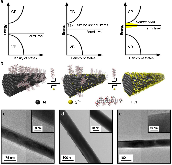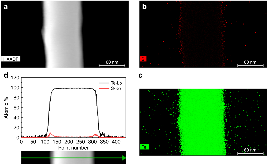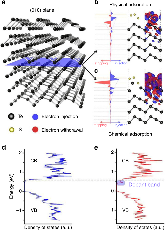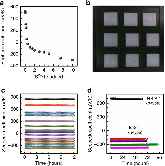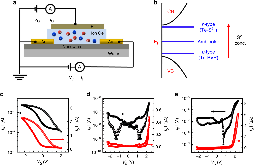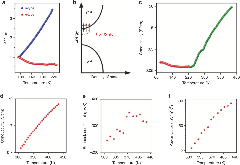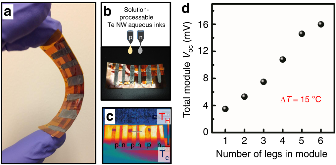|
Polymer films with ultrahigh thermoelectric properties arising from significant seebeck coefficient enhancement by ion accumulation on surface
|
journal
|
September 2018 |
|
Generalized Gradient Approximation Made Simple
|
journal
|
October 1996 |
|
Significantly Enhanced Thermoelectric Properties of PEDOT:PSS Films through Sequential Post-Treatments with Common Acids and Bases
|
journal
|
December 2016 |
|
The Effects of the Size and the Doping Concentration on the Power Factor of n-type Lead Telluride Nanocrystals for Thermoelectric Energy Conversion
|
journal
|
February 2014 |
|
Projector augmented-wave method
|
journal
|
December 1994 |
|
On the metallic states in highly conducting iodine-doped polyacetylene
|
journal
|
November 1990 |
|
Tellurium: Fast Electrical and Atomic Transport along the Weak Interaction Direction
|
journal
|
January 2018 |
|
Flexible thermoelectric materials and device optimization for wearable energy harvesting
|
journal
|
January 2015 |
|
Complex thermoelectric materials
|
journal
|
February 2008 |
|
High-performance and flexible thermoelectric films by screen printing solution-processed nanoplate crystals
|
journal
|
September 2016 |
|
Compliant and stretchable thermoelectric coils for energy harvesting in miniature flexible devices
|
journal
|
November 2018 |
|
Molecular Level Insight into Enhanced n‐Type Transport in Solution‐Printed Hybrid Thermoelectrics
|
journal
|
February 2019 |
|
High thermoelectric performance by resonant dopant indium in nanostructured SnTe
|
journal
|
July 2013 |
|
Thermoelectric figure of merit of a one-dimensional conductor
|
journal
|
June 1993 |
|
New Directions for Low-Dimensional Thermoelectric Materials
|
journal
|
April 2007 |
|
The best thermoelectric.
|
journal
|
July 1996 |
|
3D printing of shape-conformable thermoelectric materials using all-inorganic Bi2Te3-based inks
|
journal
|
January 2018 |
|
The Masses of Free Holes and Electrons in Tellurium
|
journal
|
April 1974 |
|
Energy harvesting for the implantable biomedical devices: issues and challenges
|
journal
|
January 2014 |
|
Progress and Perspective: Soft Thermoelectric Materials for Wearable and Internet‐of‐Things Applications
|
journal
|
February 2019 |
|
Printable ion-gel gate dielectrics for low-voltage polymer thin-film transistors on plastic
|
journal
|
October 2008 |
|
Enhancement of Thermoelectric Efficiency in PbTe by Distortion of the Electronic Density of States
|
journal
|
July 2008 |
|
Polymer morphology and interfacial charge transfer dominate over energy-dependent scattering in organic-inorganic thermoelectrics
|
journal
|
December 2018 |
|
Raman Spectra and Lattice Dynamics of Tellurium
|
journal
|
July 1971 |
|
Enhanced Thermopower in PbSe Nanocrystal Quantum Dot Superlattices
|
journal
|
August 2008 |
|
n-type colloidal semiconductor nanocrystals
|
journal
|
October 2000 |
|
P-type doping of elemental bismuth with indium, gallium and tin: a novel doping mechanism in solids
|
journal
|
January 2015 |
|
Thermoelectric Materials, Phenomena, and Applications: A Bird's Eye View
|
journal
|
March 2006 |
|
Resonant levels in bulk thermoelectric semiconductors
|
journal
|
January 2012 |
|
Synthesis and Characterization of Monodisperse Nanocrystals and Close-Packed Nanocrystal Assemblies
|
journal
|
August 2000 |
|
Thermal Conductivity Reduction and Thermoelectric Figure of Merit Increase by Embedding Nanoparticles in Crystalline Semiconductors
|
journal
|
February 2006 |
|
Magnetoabsorptionsmessungen an Tellur
|
journal
|
January 1968 |
|
Synthesis and Thermoelectric Characterization of Bi2Te3 Nanoparticles
|
journal
|
November 2009 |
|
Thin-film thermoelectric devices with high room-temperature figures of merit
|
journal
|
October 2001 |
|
Rational Synthesis of Ultrathin n-Type Bi2Te3 Nanowires with Enhanced Thermoelectric Properties
|
journal
|
November 2011 |
|
Tellurium as a high-performance elemental thermoelectric
|
journal
|
January 2016 |
|
On the Generation of Free Radical Species from Quantum Dots
|
journal
|
July 2005 |
|
The maximum possible conversion efficiency of silicon‐germanium thermoelectric generators
|
journal
|
September 1991 |
|
High Conductivity and Electron-Transfer Validation in an n-Type Fluoride-Anion-Doped Polymer for Thermoelectrics in Air
|
journal
|
July 2017 |
|
PbSe Nanocrystal Solids for n- and p-Channel Thin Film Field-Effect Transistors
|
journal
|
October 2005 |
|
Silicon nanowires as efficient thermoelectric materials
|
journal
|
January 2008 |
|
Titanium Sulfides as Intercalation-Type Cathode Materials for Rechargeable Aluminum Batteries
|
journal
|
June 2017 |
|
Enhanced Molecular Packing of a Conjugated Polymer with High Organic Thermoelectric Power Factor
|
journal
|
September 2016 |
|
Quantum Dot Superlattice Thermoelectric Materials and Devices
|
journal
|
September 2002 |
|
Nanostructured Thermoelectrics: Big Efficiency Gains from Small Features
|
journal
|
July 2010 |
|
Modulation of Thermoelectric Power Factor via Radial Dopant Inhomogeneity in B-Doped Si Nanowires
|
journal
|
August 2014 |
|
Effect of Interfacial Properties on Polymer-Nanocrystal Thermoelectric Transport
|
journal
|
January 2013 |
|
High-Performance Flexible Thermoelectric Power Generator Using Laser Multiscanning Lift-Off Process
|
journal
|
November 2016 |
|
Enhanced thermoelectric performance of rough silicon nanowires
|
journal
|
January 2008 |
|
Enhanced Thermoelectric Properties in Bulk Nanowire Heterostructure-Based Nanocomposites through Minority Carrier Blocking
|
journal
|
January 2015 |
|
Enhancement of thermoelectric figure-of-merit by resonant states of aluminium doping in lead selenide
|
journal
|
January 2012 |
|
Efficient iterative schemes for ab initio total-energy calculations using a plane-wave basis set
|
journal
|
October 1996 |
|
Cooling, Heating, Generating Power, and Recovering Waste Heat with Thermoelectric Systems
|
journal
|
September 2008 |
|
Solution-printable fullerene/TiS 2 organic/inorganic hybrids for high-performance flexible n-type thermoelectrics
|
journal
|
January 2018 |
|
Materials and Mechanics for Stretchable Electronics
|
journal
|
March 2010 |
|
Atoms, molecules, solids, and surfaces: Applications of the generalized gradient approximation for exchange and correlation
|
journal
|
September 1992 |
|
Improved performance and stability in quantum dot solar cells through band alignment engineering
|
journal
|
May 2014 |
|
Metal-free Inorganic Ligands for Colloidal Nanocrystals: S2–, HS–, Se2–, HSe–, Te2–, HTe–, TeS32–, OH–, and NH2– as Surface Ligands
|
journal
|
July 2011 |
|
Chromium as resonant donor impurity in PbTe
|
journal
|
January 2012 |
|
Design Principle of Telluride-Based Nanowire Heterostructures for Potential Thermoelectric Applications
|
journal
|
June 2012 |
|
Resonant level formed by tin in and the enhancement of room-temperature thermoelectric power
|
journal
|
December 2009 |
|
Enhancement of Thermoelectric Properties by Modulation-Doping in Silicon Germanium Alloy Nanocomposites
|
journal
|
January 2012 |
|
Toward High Performance n -Type Thermoelectric Materials by Rational Modification of BDPPV Backbones
|
journal
|
May 2015 |
|
High-Thermoelectric Performance of Nanostructured Bismuth Antimony Telluride Bulk Alloys
|
journal
|
May 2008 |
|
Titanium forms a resonant level in the conduction band of PbTe
|
journal
|
November 2011 |
